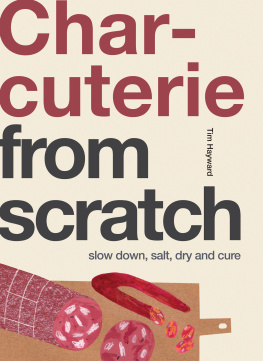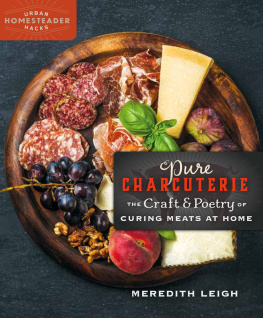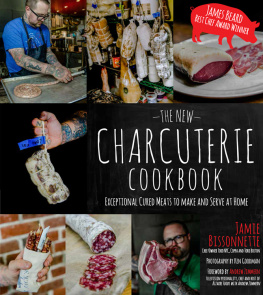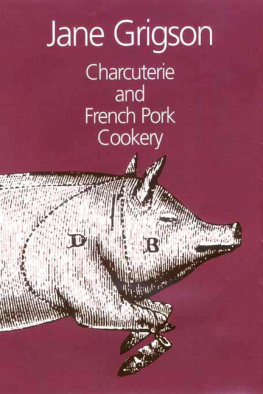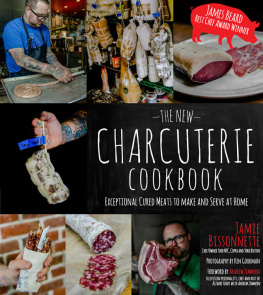CONTENTS
LIST OF RECIPES
ABOUT THE BOOK
The tradition of preserving meats is one of the oldest of all the food arts. Yet, most people simply associate charcuterie with a delicious platter of meats at a restaurant.
But real charcuterie goes well beyond that. At its most basic level it is the technique of seasoning, processing, and preserving meat, but the charcutiers bounty ranges from sausages and hams to stuffed game birds and elaborate roasts. Charcuterie can be a succulent confit duck leg on a bed of crisp greens, a rich and meaty stew, or a picnic blanket laden with pts, pickled vegetables and slices of fragrant salami.
With over 125 recipes and fully illustrated instructions for making brined, smoked, cured, skewered, braised, rolled, tied, and stuffed meats, plus a primer on whole-animal butchery, this definitive cookbook explains professional techniques that will enable home cooks to experience restaurant-quality meat every day and take their meat cooking to the next level.
Start with a whole hog middle, stuff it with herbs and spices, then roll it, tie it, and roast it for a ridiculously succulent take on porchetta. Or brandy your own prunes to stuff a decadent duck terrine. If its sausage you crave, grind, case, link, loop and smoke your own kolbsz. This book will help you fill your larder with jars of suet and drippings, tubs of flavoured butter and pots of confit. It will show you how to turn a haunch of pork into creamy lard, a heady broth or a smoked ham, and how to whip up an elegant pt, a hearty pot of soup, or a mess of savoury scones.
With its impeccably tested recipes, this instructive and inspiring tome is destined to become the go-to reference on charcuterie a treasure for anyone fascinated by the art of cooking with and preserving meat and an indispensable classic for years to come.
ABOUT THE AUTHORS
TAYLOR BOETTICHER and TOPONIA MILLER are the husband-and-wife team behind the Fatted Calf Charcuterie, which they opened in San Francisco and Napa after apprenticing with the legendary Tuscan butcher Dario Cecchini (made famous by Bill Buford's kitchen memoir Heat). The couple met at the Culinary Institute of America in Hyde Park, then moved to the Bay Area and worked in restaurants including Mustards and The Caf at MOMA.
INTRODUCTION: COME ON IN
WHEN YOU FIRST walk through the doors of the charcuterie, it feels as if youve entered an enchanted world of meaty wonders. The aroma of crispy-skinned pork roast fills the shop, inviting you to try a bite. Our cases are filled with pts, salumi , sausages, roasts, and terrines and when the meat counter crew offers you a slice of the fennel-flecked sbriciolona and a piece of head cheese, its hard to say no. Walk back into our kitchen and youll smell spices toasting, bones roasting, and broths simmering. Someone is churning out coils of fresh sausage from the hand-cranked stuffer, and someone else is hanging huge, freshly-cased cotechino on hooks for fermentation. Were hand-shredding a veritable vat of duck rillettes, seasoning it with freshly chopped thyme, then packing it into jars and sealing each with a creamy layer of duck fat. Bacon has just finished in the smoker! Go ahead and tear a hot piece off the end of the glistening slab. Peer into our curing room where row upon row of salami, guanciale , and pancetta hang quietly, patiently, enrobed in a delicate snowy bloom of mould.
If you are curious and want to know how all of this works if a hunger stirs inside of you and you feel somehow strangely at home then you are in the right place. Welcome to the Fatted Calf Charcuterie.
A charcuterie is a bit of a strange business, and the Fatted Calf is an unusual charcuterie. More than just a butchers, we offer meaty goods and services that are varied and unique. Pick out a duck or a slab of ribs and well cook it up for you. Want us to wrap and season your pork tenderloin? No problem. Craving a dish you ate at a little roadside restaurant in Burgundy and need wads of lacy caul fat and pork jowl to recreate it? We have it here. At the Fatted Calf, we butcher whole hogs, goats, and lamb. We sell chicken, duck, rabbit, and quail. We make our own sausage, pts, terrines, and potted meats. We cure salumi , smoke pastrami, and roast porchetta. We think about, talk about, and share our love of good meat from the moment we open until we close each day. We also teach butchery and charcuterie-making classes because we want to pass on the knowledge weve acquired to you.
Most people associate charcuterie with a trip to Paris or a delicious platter of meats at a restaurant. But real charcuterie goes well beyond that. The charcutier transforms the bounty of the farm and forest into a delicious subset of cuisine, which ranges from sausages and hams to stuffed game birds and elaborate roasts. At its most basic level, charcuterie is the technique of seasoning, processing, and preserving meat. But it is also a way of preserving food cultures and traditions, and enriching our daily habit of breaking bread. It is a holistic approach to cooking and eating meat and a rewarding, hands-on way to connect with our food. At the Fatted Calf, charcuterie is a way of life an approach to cooking and eating that celebrates the pleasures of the table. Charcuterie can be a succulent confit duck leg atop a bed of crisp greens; a rich and meaty stew on a cold winters night; or a picnic blanket spread in the shade of an old tree, laden with half-empty crocks of pt, dishes with pickled vegetables, and slices of fragrant salami.
For as long as people have needed to preserve their meat, charcuterie has existed in one form or another. However, it was the Romans (sticklers for rules that they were) who first codified the laws of meat preservation. Charcuterie began to blossom in earnest in France during the Middle Ages, when an official guild system was put in place to regulate the production of processed meat products. This gave birth to the delicatessen-like shops, also known as charcuteries , where the products were sold.
Over time, many of the techniques first developed in France and Italy (such as salting hams for prosciutti and processing meat into loaves or terrines) spread to the neighbouring countries of Germany, Spain, and beyond. Local predilections and ingredient availability produced countless regional charcuterie specialities, including speck, Jamn Serrano , and many, many more. In both Europe and the Americas, the industrial revolution hastened the charcuterie boom: swarms of people left the farm to work in urban factories, and thus lost access to proper kitchens and fresh meat products. The charcuterie or delicatessen became a necessity, a place where you could buy the makings of a simple meal with minimal effort. By the turn of the twentieth century, in major cities like Milan, Paris, or New York, you couldnt throw a stone without hitting a salumeria , charcuterie, or deli.



